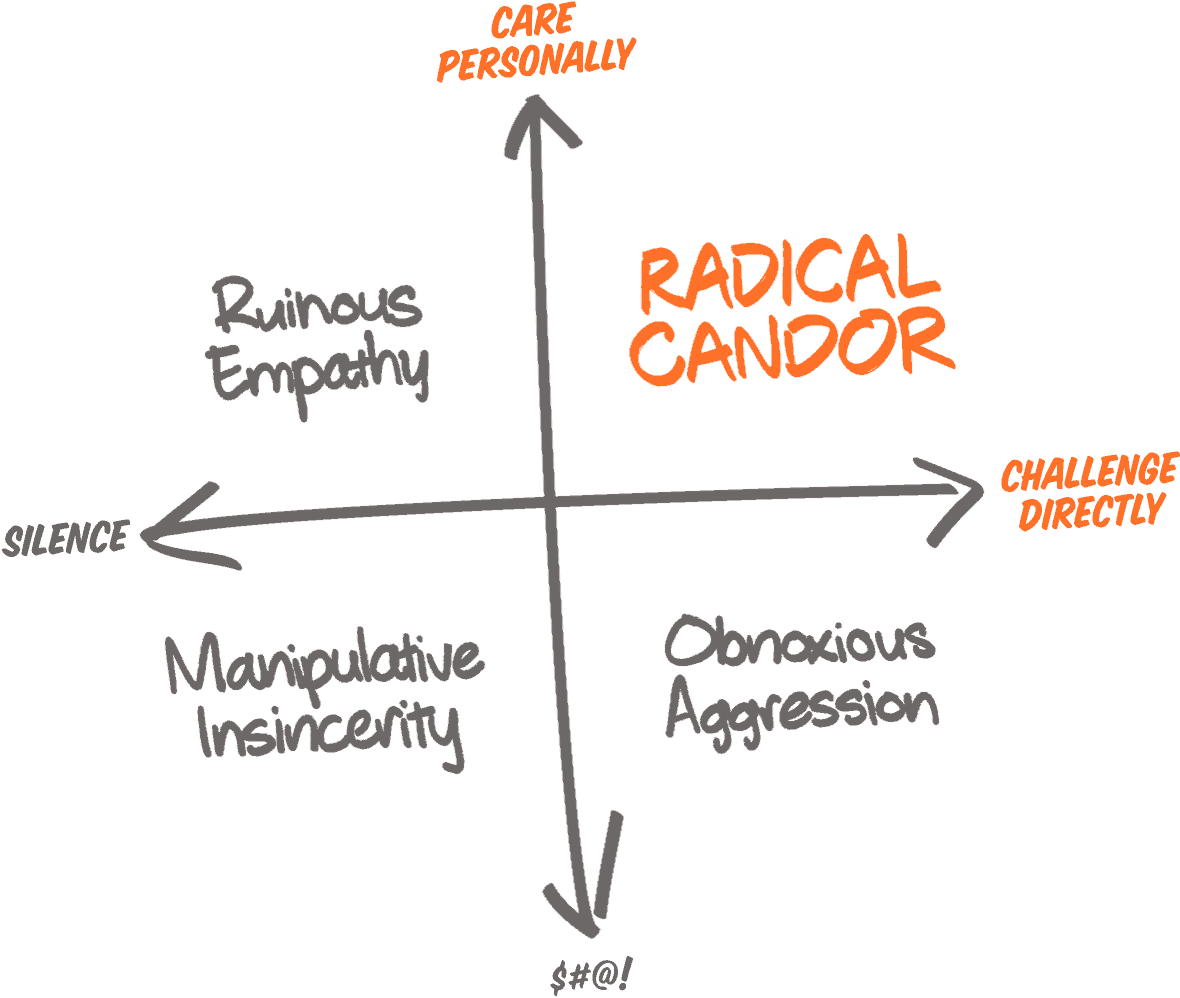It’s no surprise that Radical Candor sounds like an intimidating idea. Most of us have been raised to be polite when interacting with others, especially in a work environment. We’re taught that “if you don’t have something nice to say, don’t say anything at all.”
In a work environment, this ethos prevents us from sharing feedback with others when we have negative thoughts. Instead of saying what we believe, we mute ourselves to remain the perfect polite people our parents told us to be.
But because we’re holding back, the actions and attitudes of others tend to remain the same because nobody tells them what is wrong and what they should work on. Therefore, instead of helping others by sharing our honest thoughts and allowing them to improve, we do them a disservice by hindering their potential progress.
This is clearly not the best way to interact with others in a professional environment. But being rudely honest is not a solution either. Luckily, Radical Candor combines both attitudes.
What Is Radical Candor?
Radical Candor is a management philosophy focused on “caring personally while challenging directly. At its core, Radical Candor is guidance and feedback that’s both kind and clear, specific and sincere.”
This term is a communication principle that has been coined by management guru Kim Scott, founder of Candor Inc. In her book, podcast, and talks, she has widely publicized the importance of this approach as a method that benefits all parties involved. Scott argues that Radical Candor allows for actionable feedback that empowers people. While constructive feedback might seem abundant in our relationships and workplaces, it’s actually not. Often, we refrain from sharing out of fear of coming across as rude or too harsh.
But practicing Radical Candor is not a synonym for rude. Rather, it’s a way of delivering tough feedback without any intention of hurting the other person. The goal is to lay the ground for improvement. While there is a fine line separating both, there is a key clear difference. In Radical Candor, the feedback giver cares personally for his or her interlocutor.
“Caring personally makes it much easier to do the next thing you have to do as a good boss, which is being willing to piss people off.” — Kim Scott, founder of Candor Inc.
What Radical Candor Is Not
While the concept of Radical Candor might be hard to understand on its own, it becomes clear when we define it by opposition to what it’s not. To clarify the difference, Candor Inc. has established a framework that identifies three other ways of giving feedback.

Obnoxious Aggression
Obnoxious aggression happens when you challenge someone directly but show no signs of empathy or caring about them. If you’re praising them, it feels insincere. And if you are criticizing them, it’s perceived as rude.
Ruinous Empathy
Ruinous empathy is the opposite of obnoxious aggression. In this case, you care personally but you fail to challenge directly to spare someone’s feelings. The problem is that you don’t communicate something that the person needs to know. If you’re praising them, you’re not specific enough to help them understand what was good. And if you are criticizing them it feels unclear. While this approach might feel safe, it ends up being unhelpful to everyone.
Manipulative Insincerity
The worst kind of feedback, manipulative insincerity takes place when you neither care personally nor challenge directly. If you are praising, it feels insincere, and you don’t provide any feedback people can build upon.
You can better understand these different types of feedback by reading some examples on Radical Candor’s website.
Why Radical Candor Is Beneficial for Leaders and Teams
One thing most successful leaders have in common is that they are able to build good relationships with colleagues. They do this by genuinely caring, showing empathy, and being honest. However, Edelman’s Trust barometer shows that only 25% of people believe their bosses have integrity.
As Kim Scott puts it, “Relationships are the core building block of doing work you love. If you can’t love the people you work with or for, it’s unlikely you’ll love the work very long. Honest feedback is the atomic building block of good management. There is nothing more damaging to human relationships than an imbalance of power. Candor is the honest broker of truth that neutralizes the imbalance”.
Radical Candor benefits individuals and teams because it improves connection and creates room for growth. When a leader gives feedback to subordinates by using Radical Candor, they are empowering them. Leaders can show their staff the truths they need to see and point them in the direction of self-improvement and progress.
Radical Candor is also a useful tool to discuss how teams can work better together, as it encourages people to be honest as a group.
How You Can Apply Radical Candor to Your Organization Step By Step
If you don’t have this practice in place in your organization yet, you should start by taking small steps. You can’t expect people to change and adapt overnight. Try the following approaches:
- Inform people: Your co-workers and subordinates will not adopt this attitude if they don’t understand its importance. Before implementing Radical Candor, take some time to explain it to the people you work with. Emphasize the benefits it will bring for each individual, as well as for the company as a whole.
- Start small: Start with something simple, such as #FeedbackFriday, where co-workers give each other feedback that is both thoughtful and actionable. Setting aside time to do this will help them take the first steps into Radical Candor.
- Be flexible: Radical Candor has a specific definition, but you don’t need to follow it to its last consequence. Remember that the point is to benefit everybody involved. So if you need to adapt, don’t be afraid to do so.
Feedback sits at the core of Radical Candor. As a manager, you will often be on the giving end, but you might also find yourself receiving it. So you should always keep this in mind:
- Get feedback from others: Before starting to offer feedback to others, start accepting it yourself. Show that you are open and ready to listen attentively.
- Give feedback to others: Implement radical candor, offering feedback that both challenges directly and shows that you care personally.
- Encourage feedback: Create processes in your organization that allow your co-workers to voice their feedback.
When giving feedback, try to follow these guidelines. This will contribute to your practice of Radical Candor and help you achieve your goals of challenging directly while showing that you care personally:
- Be humble: Bbe assertive and support your feedback with data and examples, but always keep in mind that you might be wrong. Be open if that’s the case.
- Be helpful: Be clear about what you think. However, being helpful doesn’t mean doing other people’s job for them. Point out what should be improved and let them work on it.
- Do it soon: Do it as soon as possible after the event you are giving feedback on. Details will be more vivid in both your minds.
- Do it in person: In person always makes the interaction feel more personal and allows you to read the other person better, adjust your speech, and tone.
- Private or public: Give criticism in private and praise in public. Criticizing people in public will make them feel attacked and diminish your chances of them truly listening to you. Praising them in public will have a multiplier effect among the team.
- Don’t personalize: Give feedback about the work, not the person who did the work.
Remember the two principles that guide Radical Candor: caring personally and challenging directly. Here are some ideas on how you can show that you care personally:
- Practice active listening
- Make use of one-on-one meetings to establish a connection to the other person
- Be mindful of the other person’s workload and aware of their priorities and processes
- Ask someone you trust how you come across to others and build on that feedback.
And here are some ways in which you can challenge directly:
- Say what you mean, without using euphemisms
- Put a focus on how the other person’s actions were perceived. (Example: instead of saying “you don’t care about the company”, try “your actions make me feel that you don’t value the company”)
- Don’t leave unresolved, unaddressed conflicts with the other person.
Conclusion
When implementing Radical Candor into your organization, keep three important key factors in mind.
The first is that there should be a shared vocabulary amongst everyone involved. If people don’t understand the goal of this approach, they won’t feel comfortable doing the change.
The second key aspect is that you must lead by example: take feedback and ask people to rate the feedback you give them.
Finally, keep in mind that the road to fully implement radical candor is long and, sometimes, windy. You won’t be able to implement it overnight, and you won’t be able to follow it all the time. But what is important is to keep going, absorbing feedback and improving each day based on it — which is exactly the goal of radical candor.

Søren Pedersen
Co-founder of Buildingbettersoftware and Agile Leadership Coach
Søren Pedersen is a strategic leadership consultant and international speaker. With more than fifteen years of software development experience at LEGO, Bang & Olufsen, and Systematic, Pedersen knows how to help clients meet their digital transformation goals by obtaining organizational efficiency, alignment, and quality assurance across organizational hierarchies and value chains. Using Agile methodologies, he specializes in value stream conversion, leadership coaching, and transformation project analysis and execution. He’s spoken at DevOps London, is a contributor for The DevOps Institute, and is a Certified Scrum Master and Product Owner.
Value Stream Optimization?
We specialize in analysing and optimizing value streams.


0 Comments